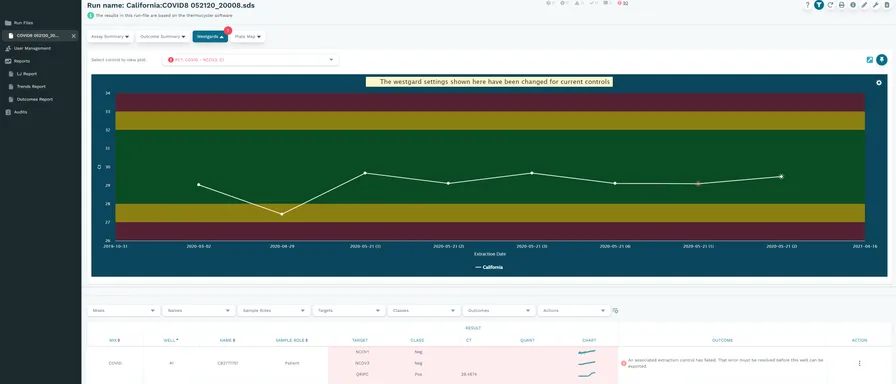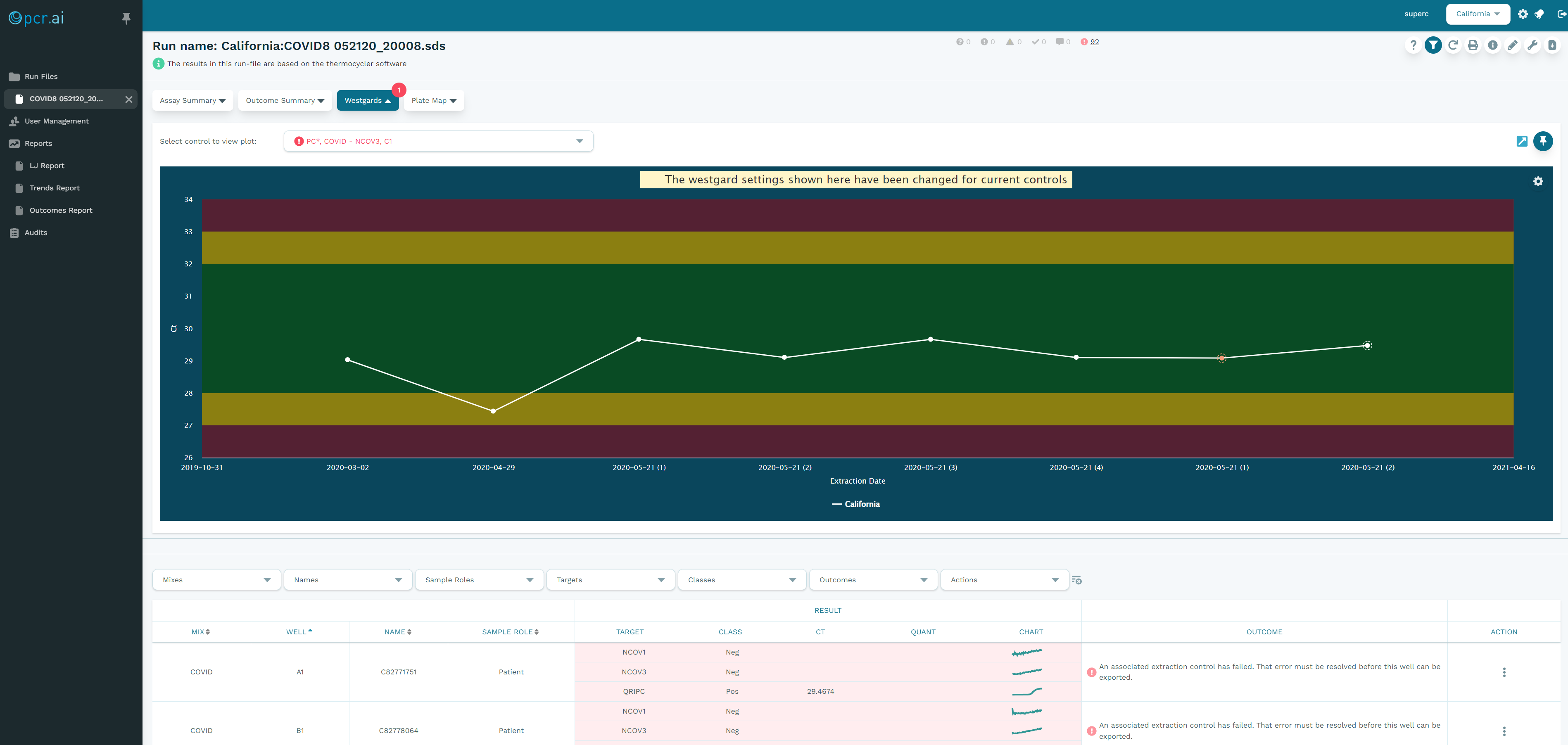- Technical Analysis
- PCR Technology
- AI Applications
The AI Advantage: Why AI Outperforms Traditional PCR Analysis Methods
A comprehensive scientific analysis of why AI-powered PCR curve analysis delivers superior accuracy compared to traditional threshold-based methods.

Introduction: The Fundamental Problem with Threshold-Based Analysis
For decades, PCR analysis has relied on threshold-based methods that examine limited data points to determine amplification. Why not simply use thresholds and other built-in cycler methods? The answer lies in understanding the fundamental limitations of these approaches and how AI-powered analysis addresses critical analytical failures.
The PCR.AI API is not reliant on thresholds or other single parameters of the curve but rather extracts multiple data-points for each curve entering the system, allowing the machine-learning to identify similar shaped curves in its training set for the assay (target).
 Figure 1: PCR.AI interface showing real-time curve analysis with Levey-Jennings control monitoring. Note the sophisticated curve shape recognition and automated quality control systems that traditional threshold methods cannot provide.
Figure 1: PCR.AI interface showing real-time curve analysis with Levey-Jennings control monitoring. Note the sophisticated curve shape recognition and automated quality control systems that traditional threshold methods cannot provide.
Critical Issues with Traditional PCR Analysis Methods
1. Standardisation Issues: The Operator Dependency Problem
Traditional PCR analysis suffers from fundamental standardisation problems that compromise reproducibility across laboratories and operators:
End-user Configuration Variability:
- Thermocycler software settings can be modified by individual users
- Different laboratories implement varying threshold strategies
- Manual baseline and threshold placement introduces subjective bias
- Run-to-run variations occur even with identical samples
Operator-Dependent Outcomes:
- Threshold placement varies between technicians
- Manual review introduces subjective interpretation
- Training level affects analytical decisions
- Experience bias influences edge-case determinations
Threshold Inconsistency:
- Fixed thresholds fail across different assay types
- Baseline fluorescence variations affect threshold validity
- Plate-to-plate variations require threshold adjustments
- Environmental conditions influence optimal threshold placement
2. False Positives Problems: When Traditional Methods Fail
Traditional threshold-based analysis generates significant false positive rates due to pattern recognition failures:
Linear Rise False Positives: Traditional methods mistake gradual baseline drift for exponential amplification. When fluorescence increases linearly rather than exponentially, threshold crossing occurs without genuine target amplification. AI recognizes the difference between linear and exponential growth patterns.
High Noise Sample Interference: Laboratory conditions introduce fluorescence artifacts that traditional methods cannot distinguish from true amplification:
- Electrical interference creates signal spikes
- Optical irregularities generate false signals
- Temperature fluctuations affect fluorescence readings
- Contamination produces unexpected fluorescence patterns
Noisy Negative Samples: Background fluorescence in negative controls can exceed threshold settings, particularly in:
- High-sensitivity assays with low thresholds
- Multiplex reactions with spectral overlap
- Aged reagents with increased background
- Environmental sample matrices with auto-fluorescence
3. False Negatives Challenges: Missed Detections
Traditional methods also fail to detect genuine amplification events due to algorithmic limitations:
Incorrect Cycle Threshold (CT) Placement:
- Low-level amplification may not reach threshold
- Unusual curve shapes confuse threshold algorithms
- Late-rising curves are missed by fixed threshold placement
- Inhibited reactions show delayed amplification kinetics
Shape Differentiation Failure: Traditional algorithms cannot distinguish between:
- Genuine exponential amplification vs. linear artifacts
- Different amplification kinetics for various targets
- Inhibited vs. uninhibited amplification patterns
- Early vs. late amplification events
Manual Review Dependencies:
- Non-standard curves require expert interpretation
- Subjective decisions introduce variability
- Time delays compromise rapid diagnostic workflows
- Inconsistent expert opinions affect reproducibility
 Figure 2: PCR.AI audit trail showing comprehensive curve analysis with automated decision-making. The system provides complete traceability of analytical decisions, including the AI’s reasoning for each curve interpretation - something impossible with traditional threshold methods.
Figure 2: PCR.AI audit trail showing comprehensive curve analysis with automated decision-making. The system provides complete traceability of analytical decisions, including the AI’s reasoning for each curve interpretation - something impossible with traditional threshold methods.
The AI Solution: Shape-Based Curve Recognition
Multi-Dimensional Data Analysis
THE PCR.AI API KNOWS THAT IT IS THE SHAPE OF THE CURVE THAT MATTERS, NOT ONLY THE CT.
While traditional methods analyze 2-3 data points per curve, AI-powered analysis examines hundreds of data points to create a comprehensive curve signature:
Comprehensive Data Extraction:
- Multiple data points extracted per curve entering the system
- Baseline characteristics analysis
- Exponential phase recognition
- Plateau phase evaluation
- Inter-curve relationship assessment
Pattern Recognition Technology:
- Machine learning identifies similar shaped curves in training set
- Assay-specific pattern libraries for each target
- Cross-reactivity pattern recognition
- Inhibition pattern identification
Eliminating Traditional Method Failures
Standardisation Through Automation:
- Zero-configuration analysis eliminates operator variables
- Consistent results across all laboratory environments
- Automated baseline and threshold determination
- Standardized decision-making algorithms
False Positive Elimination:
- Linear rise pattern recognition prevents baseline drift false positives
- Noise pattern filtering eliminates artifact-based calls
- Spectral analysis prevents cross-talk false positives
- Environmental artifact recognition
False Negative Prevention:
- Low-level amplification detection through shape analysis
- Inhibited reaction recognition and compensation
- Delayed amplification pattern identification
- Unusual kinetics accommodation
Clinical Evidence: Validated Superior Performance
The AI approach has been validated through extensive clinical studies:
NHS Glasgow Foundation Study (Journal of Clinical Virology, 2020):
- Over 20,000 real-time PCR results analyzed
- Greater accuracy than double specialist review
- 90% reduction in hands-on time
- Superior performance across all sample types
Multi-Site Validation Studies:
- University of Washington: 4,496 samples, 100% concordance
- DuPont Pioneer: 4,000+ samples, 99.8% concordance
- St. Georges NHS Trust: 2,500+ samples, 99.1% concordance
Technical Implementation: From Theory to Practice
Machine Learning Architecture
Training Dataset Composition:
- Millions of verified PCR curves from clinical laboratories
- Diverse assay types and target organisms
- Multiple thermocycler platforms and reagent systems
- Various sample matrices and inhibition conditions
Pattern Recognition Algorithms:
- Deep learning neural networks for curve shape analysis
- Ensemble methods for robust decision-making
- Continuous learning from new data inputs
- Assay-specific model optimization
Quality Control Integration:
- Automated Levey-Jennings monitoring
- Statistical process control implementation
- Drift detection and correction
- Performance metrics tracking
Real-World Implementation Benefits
Laboratory Workflow Optimization:
- Automated result interpretation eliminates manual review
- Standardized protocols across all operators
- Reduced training requirements for technical staff
- Consistent performance regardless of experience level
Regulatory Compliance:
- CE-IVDR certification ensures medical device compliance
- Complete audit trails for regulatory documentation
- Standardized analytical procedures
- Validated performance characteristics
Economic Impact:
- Reduced labor costs through automation
- Decreased error rates and associated costs
- Improved throughput and efficiency
- Reduced need for specialist interpretation
Conclusion: The Paradigm Shift in PCR Analysis
The transition from threshold-based to AI-powered PCR analysis represents a fundamental paradigm shift in molecular diagnostics. Traditional methods, developed decades ago, are limited by their reliance on oversimplified mathematical models and operator-dependent variables.
AI-powered analysis addresses every major limitation of traditional methods:
- Standardisation through automated, consistent algorithms
- Accuracy through comprehensive curve shape analysis
- Reliability through pattern recognition and artifact elimination
- Efficiency through automated interpretation and quality control
The shape of the curve matters, not only the CT. This fundamental insight drives the superior performance of AI-powered analysis and represents the future of molecular diagnostic technology.
For laboratories seeking to improve accuracy, reduce costs, and standardize operations, AI-powered PCR analysis offers a validated, clinically-proven solution that outperforms traditional threshold methods across all performance metrics.
This technical analysis is based on peer-reviewed clinical studies and validated performance data from NHS laboratories, academic institutions, and commercial diagnostic facilities worldwide.